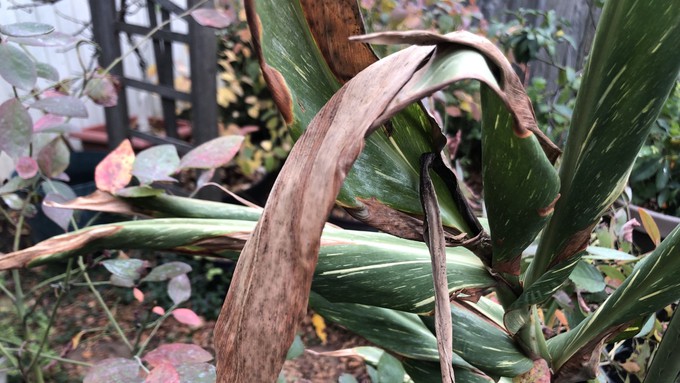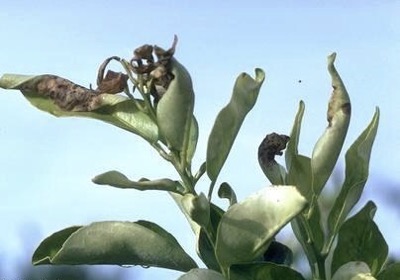
Problems may become evident when temperatures warm

Is this frost damage or something else? Since it's an ornamental ginger plant -- a frost-tender tropical -- it's probably been damaged in the recent frosty weather. Kathy Morrison
Did your garden dodge damage from recent frost? Look again.
Frost damage may not appear immediately, say UC agriculture experts and master gardeners. Browned leaves and dieback may appear days, even weeks later.
“Often injury is not apparent until days after a freeze and when temperatures rise,” say the UC IPM pest notes.

Downtown Sacramento hit lows of 32 degrees on Dec. 17 and 18. Seven December nights (so far) dipped down to 35 or below. Surrounding areas saw lows below freezing.
It’s not just how low temperatures dropped but how long those cold periods last. Most plants can withstand a few minutes of freezing temperatures – but not a few hours.
Frost damage looks like other kinds of damage, notes the UC experts. “Symptoms resembling freezing and frost injury are also caused by anthracnose and other leaf and shoot diseases, gas or mechanical injury to roots, phytotoxicity, and water deficit.” (That last category is very common after years of drought.)
Frost damage is often described as “burn,” because that’s how the plant looks – as if it was torched.
“Cold temperature damage causes buds, flowers, and shoots to curl, turn brown or black, and die,” say the UC experts. “Foliage appears scorched because low temperatures severely dehydrate plant tissue. Bark and wood can crack or split, and whole branches or entire plants may be killed if temperatures are below those tolerated by the plant.”
Frost and freezing aren’t the same thing, note the experts.
“Frost and freezing produce the same damage but occur under different conditions, and some of their management strategies differ. Freezing occurs when air temperatures are 32 degrees F. or colder. Frost occurs when air is warmer than 32 degrees F. but plant tissues drop to 32 degrees F. or below because plants radiate (lose) heat into the atmosphere, especially during cool, clear nights.”
So, a tender plant – such as succulents or tropicals – can suffer frost damage even if the temperature stays above freezing.
UC experts recommend removing mulch from under and around frost-sensitive plants to increase the bare soil’s ability to absorb heat and warm plants.
Moist soil holds more heat. When frost is in the forecast, irrigate topsoil so it has a chance to absorb more warmth – preferably at least three days before frost is expected, say the experts.
What can you do in a hurry? Use cloth – not plastic – covers, UC experts say; cloth is better at retaining heat. “When frost is expected, cover sensitive plants overnight with cloth or similar material other than plastic to reduce heat loss to the atmosphere, but leave covers open at their bottom so heat from soil can help warm plants. Remove covers during the day.”
Just covering a plant may not be enough to save it, note the experts. “During freezing, covering plants is of little help unless a heat source is provided. Placing incandescent lights designed for outdoor use in the canopy may generate enough heat to prevent plants from freezing if plants are also covered. Be sure not to create electrical shock or fire hazards.”
When frost damage does occur, leave it – at least for a while. It will help protect the plant from more frost damage this winter. And it might not be totally dead.
“Do not prune freeze-damaged plants until after you are certain what tissues are dead, preferably by waiting until spring or summer after new growth begins,” say the UC experts.
Instead, prune damage in spring after all frost danger has passed.
For more tips: https://ipm.ucanr.edu/PMG/GARDEN/ENVIRON/frostdamage.html
Comments
0 comments have been posted.Sacramento Digs Gardening to your inbox.
Food in My Back Yard Series
May 6: Maintain soil moisture with mulch for garden success
April 29: What's (already) wrong with my tomato plants?
April 22: Should you stock up on fertilizer? (Yes!)
April 15: Grow culinary herbs in containers
April 8: When to plant summer vegetables
April 1: Don't be fooled by these garden myths
March 25: Fertilizer tips: How to 'feed' your vegetables for healthy growth
March 18: Time to give vegetable seedlings some more space
March 11: Ways to win the fight against weeds
March 4: Potatoes from the garden
Feb. 25: Plant a fruit tree now -- for later
Feb. 18: How to squeeze more food into less space
Feb. 11: When to plant? Consider staggering your transplants
Feb. 4: Starting in seed starting
Sites We Like
Garden Checklist for week of May 11
Make the most of the lower temperatures early in the week. We’ll be back in the 80s by Thursday.
* Plant, plant, plant! It’s prime planting season in the Sacramento area. Time to set out those tomato transplants along with peppers and eggplants. Pinch off any flowers on new transplants to make them concentrate on establishing roots instead of setting premature fruit.
* Direct-seed melons, cucumbers, summer squash, corn, radishes, pumpkins and annual herbs such as basil.
* Harvest cabbage, lettuce, peas and green onions.
* In the flower garden, direct-seed sunflowers, cosmos, salvia, zinnias, marigolds, celosia and asters. (You also can transplant seedlings for many of the same flowers.)
* Plant dahlia tubers.
* Transplant petunias, marigolds and perennial flowers such as astilbe, columbine, coneflowers, coreopsis, dahlias, rudbeckia and verbena.
* Keep an eye out for slugs, snails, earwigs and aphids that want to dine on tender new growth.
* Feed summer bloomers with a balanced fertilizer.
* For continued bloom, cut off spent flowers on roses as well as other flowering plants.
* Add mulch to the garden to maintain moisture. Mulch also cuts down on weeds. But don’t let it mound around the stems or trunks of trees or shrubs. Leave about a 6-inch-to-1-foot circle to avoid crown rot or other problems.
* Remember to weed! Pull those nasties before they set seed.
* Water early in the day and keep seedlings evenly moist.